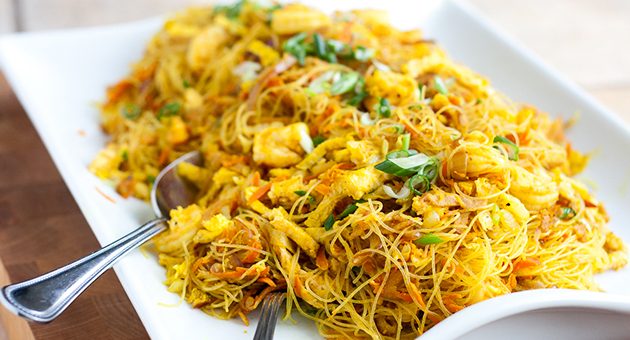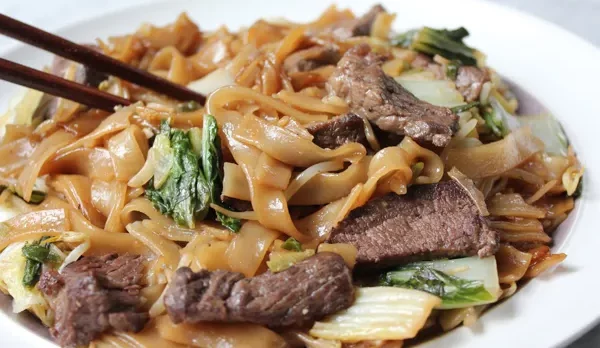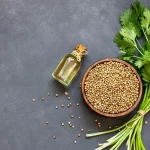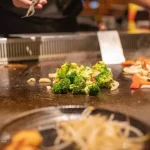Mei Fun vs Chow Fun
The duo of mei fun and chow fun noodles are a tiny piece of the sea of popular Chinese noodles. Though noodles are an integral part of Chinese cuisines, chow fun and mei fun noodles took it to a totally different level. This is due to many reasons which you would figure out later in the article. But with this level of popularity in the world of Chinese cuisines comes comparisons between the two very popular types of noodles, it necessitated the mei fun vs chow fun comparison that we are working on right now.
If you are a lover of noodles, specifically Chinese noodles, then the chow fun vs mei fun comparison article would greatly interest you and guide you in choosing what noodle is best for your need.
What is Mei Fun?

Mei Fun noodles, also known as mai fun, are thin rice noodles commonly used in Asian cuisine. These delicate noodles have a silky texture and a neutral flavor, making them a versatile ingredient that can be used in a wide range of dishes.
Mei Fun noodles are typically sold dried and need to be rehydrated before use. Follow the instructions on the packaging for the best results. Once the noodles are pliable, drain them and set them aside.
Mei Fun noodles are often featured in stir-fries, where they absorb the flavors of the other ingredients. To create a delicious Mei Fun dish, gather your preferred proteins, vegetables, and seasonings.
In terms of proteins, you have numerous options. Common choices include sliced chicken, shrimp, beef, or tofu. You can also combine different proteins or make a vegetarian version by using a variety of vegetables or tofu as the main component.
Prepare your proteins by marinating them to infuse them with flavor. A simple marinade could consist of soy sauce, oyster sauce, minced garlic, a pinch of sugar, and a splash of sesame oil (check out sesame chicken vs orange chicken). Let the proteins marinate for at least 15 minutes to allow the flavors to penetrate.
Mei Fun noodles pair well with a variety of vegetables such as bell peppers, onions, carrots, snow peas, bean sprouts, and scallions.
Mei Fun noodles can be enjoyed as a stand-alone dish or served as a side alongside other Chinese or Asian dishes. They are light, flavorful, and versatile, making them a perfect choice for a quick and satisfying meal.
Don’t be afraid to experiment with different combinations of proteins, vegetables, and seasonings to create your own unique Mei Fun masterpiece. Enjoy the delicate texture and delightful flavors of these delicious rice noodles and let your culinary creativity shine.
What is Chow Fun?

Chow Fun noodles, also known as Ho Fun or Shahe Fen, are a popular staple in Chinese cuisine. These wide, flat rice noodles (See the rice noodles vs egg noodles comparison) have a delightful chewy texture and are often featured in various stir-fried dishes.
Chow Fun noodles are versatile and can be adapted to suit various tastes and dietary preferences. Feel free to experiment with different proteins, vegetables, and sauces to create your signature dish. Whether you enjoy the classic beef Chow Fun or prefer a vegetarian or seafood version, these delicious noodles are sure to satisfy your cravings and impress your family and friends with your culinary skills.
Chow Fun vs Mei Fun Comparison
The key differences and similarities that make these two awesome Asian noodles some of the most popular and desirable have been compiled below;
Noodle Texture:
- Chow Fun Noodles: Chow Fun noodles are wide, flat rice noodles. They have a chewy texture and a slightly denser bite due to their width. They can withstand high heat and longer cooking times without becoming mushy.
- Mei Fun Noodles: Mei Fun noodles, also known as rice vermicelli, are thin rice noodles. They have a delicate and silky texture, often described as soft and slippery. They cook quickly and can become soft and tender with minimal cooking time.
Cooking Method:
- Chow Fun Noodles: Chow Fun noodles are often stir-fried in a hot wok or skillet. Due to their thickness, they require slightly longer cooking time to ensure they are evenly heated and coated with the flavors from the ingredients.
- Mei Fun Noodles: Mei Fun noodles are typically boiled or soaked in hot water until they are rehydrated and pliable. They can be stir-fried briefly with other ingredients or added directly to soups or salads without further cooking.
Flavor Absorption:
- Chow Fun Noodles: Chow Fun noodles have a slightly more substantial texture, allowing them to absorb sauces and flavors from the ingredients they are cooked with. They can hold up well to bold flavors and intense seasonings, making them an excellent choice for stir-fried dishes.
- Mei Fun Noodles: Mei Fun noodles have a more delicate texture and a milder taste. They tend to absorb flavors quickly and can easily take on the taste of the sauces and ingredients they are paired with. Mei Fun noodles work well in dishes where the flavors of the other components shine.
Dish Adaptability:
- Chow Fun Noodles: Chow Fun noodles are commonly used in Chinese cuisine and are a staple in dishes like Beef Chow Fun. Their wider shape and chewy texture make them suitable for hearty stir-fries and noodle soups. They can hold up well with various proteins and vegetables.
- Mei Fun Noodles: Mei Fun noodles are widely used in various Asian cuisines, such as Vietnamese, Thai, and Singaporean. Their delicate nature and quick cooking time make them versatile for salads, cold dishes, stir-fries, and soups. They are often paired with lighter ingredients and flavors.
Both Chow Fun and Mei Fun noodles have their unique characteristics and can be enjoyed in different ways depending on your preference. Whether you prefer the chewy and robust nature of Chow Fun or the delicate and soft texture of Mei Fun, both noodles can be incorporated into a wide range of delicious dishes to satisfy your culinary cravings.
Below is a tabular representation of the features of chow fun noodles in comparison to those of mei fun noodles. This tabular representation is meant to aid easier understanding of the differences and similarities of the noodles. With the below table the mei fun vs chow fun debate should be settled.
Mei Fun vs Chow Fun Comparison Table
| Features | Chow Fun Noodles | Mei Fun Noodles |
|---|---|---|
| Noodle Texture | Wide, flat, chewy texture | Thin, delicate, silky texture |
| Cooking Method | Stir-fried in a wok or skillet | Boiled or soaked, quick stir-frying or boiling |
| Flavor Absorption | Absorbs flavors, holds up well to sauces | Absorbs flavors quickly, takes on other tastes |
| Dish Adaptability | Common in Chinese cuisine | Widely used in Asian cuisines |
| Typical Dishes | Beef Chow Fun, stir-fried noodle dishes | Mei Fun salads, stir-fries, soups |
| Ingredient Pairing | Hearty proteins, bold flavors | Lighter proteins, delicate ingredients |
| Cooking Time | Longer cooking time | Quick cooking time |
Remember that these are general characteristics and features of these two noodles, and there could be variations in specific recipes and regional preferences. Both Chow Fun and Mei Fun noodles offer unique textures and culinary possibilities, allowing you to create delicious dishes based on your personal taste and preferences.



